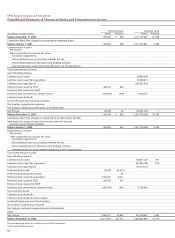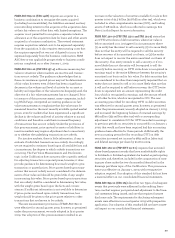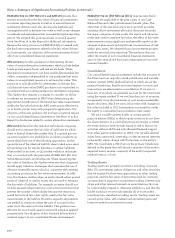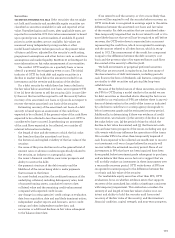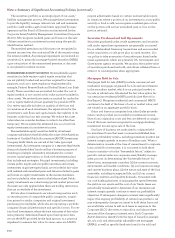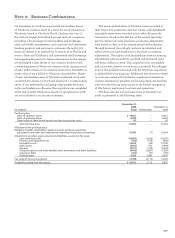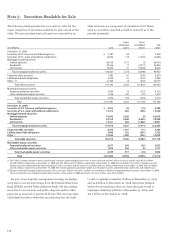Wells Fargo 2009 Annual Report Download - page 104
Download and view the complete annual report
Please find page 104 of the 2009 Wells Fargo annual report below. You can navigate through the pages in the report by either clicking on the pages listed below, or by using the keyword search tool below to find specific information within the annual report.
Note 1: Summary of Significant Accounting Policies (continued)
The securities portfolio is an integral part of our asset/
liability management process. We manage these investments
to provide liquidity, manage interest rate risk and maximize
portfolio yield within capital risk limits approved by man-
agement and the Board of Directors and monitored by the
Corporate Asset/Liability Management Committee (Corporate
ALCO). We recognize realized gains and losses on the sale
of these securities in noninterest income using the specific
identification method.
Unamortized premiums and discounts are recognized in
interest income over the contractual life of the security using
the interest method. As principal repayments are received on
securities (i.e., primarily mortgage-backed securities (MBS))
a pro-rata portion of the unamortized premium or discount
is recognized in interest income.
NONMARKETABLE EQUITY SECURITIES Nonmarketable equity
securities include venture capital equity securities that
are not publicly traded and securities acquired for various
purposes, such as to meet regulatory requirements (for
example, Federal Reserve Bank and Federal Home Loan Bank
stock). These securities are accounted for under the cost or
equity method or are carried at fair value and are included in
other assets. We review those assets accounted for under the
cost or equity method at least quarterly for possible OTTI.
Our review typically includes an analysis of the facts and
circumstances of each investment, the expectations for the
investment’s cash flows and capital needs, the viability of its
business model and our exit strategy. We reduce the asset
value when we consider declines in value to be other than
temporary. We recognize the estimated loss as a loss from
equity investments in noninterest income.
Nonmarketable equity securities held by investment
company subsidiaries that fall within the scope of the American
Institute of Certified Public Accountants (AICPA) Investment
Company Audit Guide are carried at fair value (principal
investments). An investment company is a separate legal entity
that pools shareholders’ funds and has a business purpose of
investing in multiple substantive investments for current
income, capital appreciation, or both, with investment plans
that include exit strategies. Principal investments, including
certain public equity and non-public securities and certain
investments in private equity funds, are recorded at fair value
with realized and unrealized gains and losses included in gains
and losses on equity investments in the income statement,
and are included in other assets in the balance sheet. Public
equity investments are valued using quoted market prices and
discounts are only applied when there are trading restrictions
that are an attribute of the investment.
Private direct investments are valued using metrics such
as security prices of comparable public companies, acquisi-
tion prices for similar companies and original investment
purchase price multiples, while also incorporating a portfolio
company’s financial performance and specific factors. For cer-
tain fund investments, where the best estimates of fair value
were primarily determined based upon fund sponsor data,
we use the NAV provided by the fund sponsor as a practical
expedient to measure fair value. In some cases, such NAVs
require adjustments based on certain unobservable inputs.
In situations where a portion of an investment in a non-public
security or fund is sold, we recognize a realized gain or loss
on the portion sold and an unrealized gain or loss on the
portion retained.
Securities Purchased and Sold Agreements
Securities purchased under resale agreements and securities
sold under repurchase agreements are generally accounted
for as collateralized financing transactions and are recorded
at the acquisition or sale price plus accrued interest. It is
our policy to take possession of securities purchased under
resale agreements, which are primarily U.S. Government and
Government agency securities. We monitor the market value
of securities purchased and sold, and obtain collateral from or
return it to counterparties when appropriate.
Mortgages Held for Sale
Mortgages held for sale (MHFS) include commercial and
residential mortgages originated for sale and securitization
in the secondary market, which is our principal market, or
for sale as whole loans. We elected the fair value option for
our new prime residential MHFS portfolio (see Note 16 in
this Report). Nonprime residential and commercial MHFS
continue to be held at the lower of cost or market value, and
are valued on an aggregate portfolio basis.
Gains and losses on nonprime loan sales (sales proceeds
minus carrying value) are recorded in noninterest income.
Direct loan origination costs and fees are deferred at origina-
tion of the loans and are recognized in mortgage banking
noninterest income upon sale of the loan.
Our lines of business are authorized to originate held-
for-investment loans that meet or exceed established loan
product profitability criteria, including minimum positive net
interest margin spreads in excess of funding costs. When a
determination is made at the time of commitment to originate
loans as held for investment, it is our intent to hold these
loans to maturity or for the “foreseeable future,” subject to
periodic review under our corporate asset/liability manage-
ment process. In determining the “foreseeable future” for
these loans, management considers (1) the current economic
environment and market conditions, (2) our business strategy
and current business plans, (3) the nature and type of the loan
receivable, including its expected life, and (4) our current
financial condition and liquidity demands. Consistent with
our core banking business of managing the spread between
the yield on our assets and the cost of our funds, loans are
periodically reevaluated to determine if our minimum net
interest margin spreads continue to meet our profitability
objectives. If subsequent changes in interest rates significantly
impact the ongoing profitability of certain loan products, we
may subsequently change our intent to hold these loans and
we would take actions to sell such loans in response to the
Corporate ALCO directives to reposition our balance sheet
because of the changes in interest rates. Such Corporate
ALCO directives identify both the type of loans (for example
3/1, 5/1, 10/1 and relationship adjustable-rate mortgages
(ARMs), as well as specific fixed-rate loans) to be sold and


